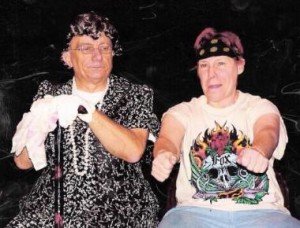RECOMMENDED
The residents of Tuna, Texas are alive and well and currently sojourning at
Metropolitan Community Church of the Valley in North Hollywood. Since MCC
of the Valley happens to have a largely gay and lesbian congregation, this
might come as a shock to some of the Tuna folks, as their hometown is not the
most forward-thinking spot in the nation. Not by a long shot.
Fortunately, Tuna is fictitious, as are its 20 residents, so there’s unlikely to be any
protest from them about the show’s edgy venue. There’s even less likelihood
of a picket line outside the church since never are there more than two of
them together at one time.
Why, you may ask, is that?
The reason is simple. All twenty of them are brought to life by a single pair of
actors. Joe Sears, Jaston Williams and Ed Howard are the co-creators of the
Tuna Trilogy (Greater Tuna, A Tuna Christmas, and Red, White and Tuna), and
for the past twenty-five odd years, Sears and Williams have made successful
careers for themselves performing ten Tuna characters each and touring the
country with their trio of shows. They were most recently amongst us about a
year ago in La Mirada, and this past Christmas, a pair of dueling Tuna
Christmases were being performed by other actors, including the near-historic
male/female pairing of Patrick Bristow and Mindy Sterling, reviewed here.
Bristow and Sterling may not have been the very first opposite sex couple to
perform a Tuna show, but they were certainly among the first, and now
Michael Anthony-Nozzi and Susie McCarthy are proving once again that this
may in fact be the ideal way to cast the show, with a male actor playing both
male and female characters, and a female actor doing the same. It’s as
much fun to see McCarthy in male drag as it is to see Nozzi bewigged and
begowned.
Each portrays 10 characters whose lives intertwine over the course of a single
day, and their backstage dressers (Jan Ambler and Carl Miller) end up doing
nearly as much work as the onstage actors in facilitating the many fast
costume changes required over the play’s two acts.
Nozzi becomes, among others:
Bertha Bumiller, whose mission in life is to rid Tuna of smut. Even words as tame
as “hot” face being stricken from local dictionaries.
Pearl Burras, a gray-haired granny with a dislike for canines, who delights in
poisoning them with what she likes to call a “bitter pill.”
Elmer Watkins, head of the local chapter of the KKK, dedicated to making the
town safe “for the right kind of people.”
Some of the characters McCarthy embodies include:
Vera Carp, town snob and vice president of the Smut-Snatchers of the New
Order.
Didi Snavely, owner of Didi’s Used Weapons (“If we can’t kill it, it’s immortal”).
Petey Fisk, young employee of the Tuna Humane Society who hasn’t the heart
to put strays to sleep, even when they’ve overstayed their welcome at the
dog pound.
Both Nozzi and McCarthy are talented performers who bring these small town
denizens to often hilarious life on the bare-bones, though effective, set.
Costumes and wigs are just fine, though it is disconcerting to catch glimpses of
a bra through the arm holes of delinquent Stanley Bumiller’s sleeveless t-shirt.
Angel Felix has done the best he can with the church’s non-theatrical lighting
system.
This production has been labor of love for Nozzi, and he deserves major kudos
for pulling it off despite several setbacks. He has directed Greater Tuna with
an experienced hand, though an outside director’s eye and voice might have
made for an even stronger production and even more vivid characterizations.
As it stands, this visit to Greater Tuna proves an enjoyable one, especially for
those who have not yet had the pleasure of meeting these marvelous
characters. Once you’ve been to Tuna, buying a can of Starkist is likely to
awaken memories and bring back a chuckle or two.
MCC In The Valley, North Hollywood.
–Steven Stanley
March 2, 2008



 Since 2007, Steven Stanley's StageSceneLA.com has spotlighted the best in Southern California theater via reviews, interviews, and its annual StageSceneLA Scenies.
Since 2007, Steven Stanley's StageSceneLA.com has spotlighted the best in Southern California theater via reviews, interviews, and its annual StageSceneLA Scenies.







 COPYRIGHT 2024 STEVEN STANLEY :: DESIGN BY
COPYRIGHT 2024 STEVEN STANLEY :: DESIGN BY